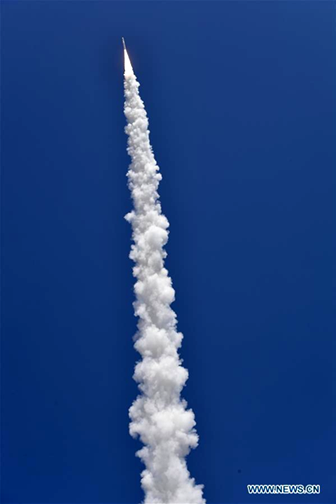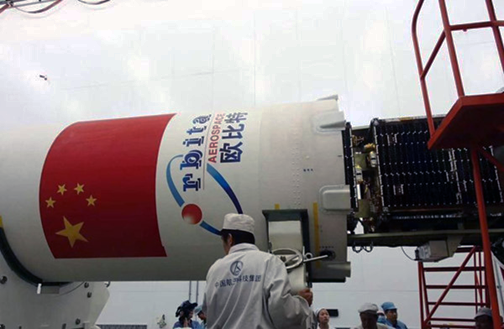
Photo taken on April 26, 2018, shows a Chinese Long March-11 carrier rocket lifting off from the Jiuquan Satellite Launch Center in Jiuquan. China on Thursday sent five Zhuhai-1 remote sensing satellites into space on a single carrier rocket.
Photo is courtesy of Xinhua/Wang Jiangbo.

Four hyperspectral satellites and one video orbiter developed by Zhuhai Orbita Aerospace Science & Technology Co were launched by China on April 26, joining two Zhuhai-1 smallsats in a growing constellation — this quartet is to improve the spatial resolution and data acquisition capabilities of the group. The satellites were rocketed from Jiuquan Satellite Launch Center in the Inner Mongolia Autonomous Region at 12:42 am, aboard a Long March (CZ-11).
The hyperspectral satellites OHS-01, 02, 03, and 04 will be able to complete a full scan of the planet’s land surface every five days, while viewing a specific area multiple times daily. This spectral information provided will be helpful in the quantitative analysis of remote-sensing data and allow for more accurate identification of ground objects, according to a designer from Zhuhai Orbita Aerospace Science & Technology Co in Tangjiawan. The technology has been widely used in resource management, environmental protection, city governance, ecology, agriculture, forestry, anti-terrorism, finance, and insurance, among other areas.
Also named Qingkeda No 1, OHS-01 was developed in cooperation with Qingdao University of Science & Technology. The OHS-03 satellite is also known as Guiyang-1. The satellites resulted from an effective industry-university-research collaboration, with support from the governments.

Second-group Zhuhai-1 satellite
Photo is courtesy of Zhuhai Orbita.
The video satellite OVS-2 has a relatively high spatial resolution of .9 meters (3 ft.) and 22.5 km. (14 miles) in the coverage of images obtained. Its ground resolution can reach .9 meters, even at an altitude of 500 km. (311 miles). High-performance processor chips and large-capacity memory, independently researched and developed by Orbita, ensure smooth operation.
This is China’s first independent private operator of a satellite constellation, with two video micro-satellites in place by June 2017. According to the company, another five satellites will be sent into space by the end of this year.
Article source: China Daily

For all involved in the satellite and space industry and the various market segments that add value to these dynamic environments, the 2020 SmallSat Symposium is truly worth your consideration for attendance.
The SmallSat Symposium is hosted by Satnews Publishers which, since 1983, has been a provider of a satellite news, media and events. This information packed forum was created to enable you and your company to secure a larger portion of market share as well as to take part in the next stages of your company’s or organization’s growth.

The personal connections at the SmallSat Symposium enable attendees to network with established organizations, subject-matter experts as well as ‘New Space’ entrants.
The SmallSat Symposium will focus on new technologies and the business environment that is shaping the implementation of smallsat constellations, smallsat launchers, the challenges facing the smallsat developer and actors as well as the enormous benefits of these advanced technologies that will benefit our world.
This event assembles more than 100 diverse speakers, all of whom possess deep industry experience. Additionally, numerous opportunities exist to mingle and network with peers while enjoying exceptional, complimentary meals and refreshment breakfast.

